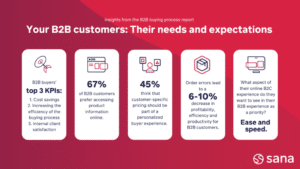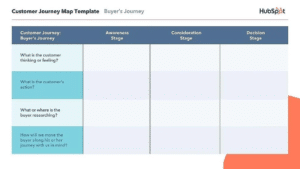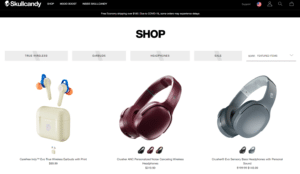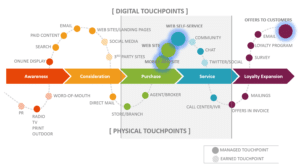In a world where customer experience is everything, the importance of optimizing B2B customer touchpoints can’t be emphasized enough. It’s possible to influence every interaction a customer has with your business, to ensure that they all contribute to a positive overall customer journey. The aim of this is to improve your conversion and retention rates. That’s why optimizing your B2B customer touchpoints is an integral part of your customer engagement strategy!

Source: Giphy
Customers have increasingly come to expect a personalized, integrated, and seamless experience from brands. In fact, 73% of people surveyed by PWC believed that CX was an important factor in purchasing decisions. B2B customers are no exception. The key to providing this experience is understanding exactly where, why, and how customer interactions occur.
If we look at this in the context of a B2B ecommerce business, let’s assume a customer places an online order for stock. Perhaps the stock doesn’t arrive when it is supposed to and the customer calls your business to complain. If the customer then follows up their phone complaint via another channel such as an email or even a Facebook message, they would expect a reply based upon the company having full details of all previous communications at their fingertips. It can be very annoying, as a customer, if you have to repeat your problem multiple times to multiple people.
The infographic below gives a brief overview of what B2B companies can expect in terms of their customers’ needs when interacting with them.

According to the insights provided here, the metrics that B2B customers tend to appreciate most revolve around value. Beyond the inherent value of the product or service you offer, your company should also be able to add value by ensuring that the processes involved in acquiring your product cater to their needs, their time, and their resources.
The next logical step is to start evaluating your current communications strategy. For example, consider your business phone system. If you’re still using a landline, perhaps it’s time to think about voice-over internet protocol (VoIP) calling. You could start by comparing the benefits of VoIP to its disadvantages. You may find that a simple upgrade could provide far better connections with current and prospective B2B customers.
Understanding customer touchpoints
What are B2B customer touchpoints? In a nutshell, they’re any points of contact between your organization and your business customers or prospects. They don’t have to be directly instigated by you, and they can vary in number. Examples include contact with a call center, viewing a social media post, or receiving an invoice.
According to a broad spectrum of data, the optimum number of B2B touchpoints is eight. However, every industry and buyer persona is different. Harnessing your unique touchpoints is an opportunity to build stronger relationships with key stakeholders within your B2B customer operations.
Identifying customer touchpoints
It is important to identify touchpoints at all stages of the customer journey. This includes before purchase, during purchase, and after purchase. Once you start to do this, you can really build out your customer journey. It’s all about understanding the process from your buyer’s point of view.
Providing the right experience or content at the right time and to the right people is vital. Developing a deep understanding of your customers’ pain points, challenges, and motivations can really help you to increase B2B customer lifetime value. Below we will look at how you can start to identify customer touchpoints for your business.
Listen to customer feedback
Customer feedback matters hugely. Carrying out customer interviews or surveys allows you to ask questions to successfully identify touchpoints. Don’t forget to ask how customers heard about you. If they discovered your brand through word of mouth, this might not be clear from other sources or forms of data.
Pay attention to your website
Website analytics can help you to identify exactly where customers are coming from. This includes which search engines or social networks are sending traffic to your site and which pages they are landing on. These are important touchpoints.
Utilize your team’s knowledge
It’s vital to understand your B2B customers’ perceptions of interactions with your business by speaking to them, but this can be time-consuming. However, your team should be able to share their pre-existing knowledge.
Customer-facing employees can provide intelligence on the most commonly asked questions, concerns, and complaints. They’ll also provide information gleaned from sales calls, product demonstrations, and trade events.
It’s important that sales calls are always recorded and utilized as a source of knowledge and training for all of your company’s departments. Look into call center recording and see how you can make use of information from sales calls. They can provide valuable insight into customer pain points and expectations.
What is customer touchpoint mapping?
Customer touchpoint mapping is the detailed process of outlining every interaction a customer could have with your business. Visually mapping out the process a prospect goes through to become a customer (known as the ‘customer journey’) can help you to understand customer behavior and thought processes. Gaining that kind of understanding will help you to lose fewer prospects along the way.

In this example, the customer journey is broken up into three steps: Awareness, Consideration, and Decision. With a map like this, it’s much easier to make sure at a glance that each of these three elements play well with each other at each stage, as well as retain some semblance of consistency throughout.
Below, we will look at some of the most significant places where B2B customers interact with brands. Read on to discover how to optimize the customer experience at each touchpoint. With B2B sales, there’s rarely a sole-decision maker, so it is important to consider each stakeholder’s interactions, too.
This is a chance to assess how all your process and procedure, people, and systems impact the service and communication which customers receive (commonly referred to as a customer experience or CX audit).
Social media
Social media channels are common customer touchpoints. The various social networks are increasingly becoming platforms for both customer service and lead generation. Maintaining social media profiles where your B2B customers are present is non-negotiable. Don’t forget that there are Facebook groups, etc. dedicated to the business community.
Digital marketing content
Optimizing digital marketing content like blogs centers on the question of whether your content is user-friendly. Are you answering common queries from your customers? Planning content is the perfect opportunity to align marketing and sales. Talk to your customer-facing counterparts for topic ideas — they’re constantly being hit with questions and objections that you can address on your website/blog.
Review content marketing examples from competitors and analyze how you measure up (use software like SEMrush or Ahrefs to compare). It might be time to refresh your content strategy to improve this touchpoint. High-quality, authoritative content is everything.
Website
Data from your analytics suite can help you to understand how to optimize your website to provide the best customer experience. Website traffic numbers are a great place to start. However, they don’t help you to understand how user-friendly your website actually is. More depth is needed.
Website visitor tracking will enable you to identify and analyze the behavior of companies visiting your site. This will ensure that you are targeting the right potential customers to close more sales.
Reports known as ‘heatmaps’ can also provide valuable intelligence, including exactly where customers are clicking and how well website forms are performing.
Check that your website copy clearly explains your products or services. Don’t assume that the reader is familiar with everything that your business offers. They may easily become confused, creating a poor experience. Try not to use jargon and be transparent with your pricing.
Use Google Analytics to analyze the effectiveness of your copy. For example, a website user who visits your pricing or product page multiple times is obviously interested in your products or services. However, they may also be confused. Sales teams should recognize these patterns and address them on pitches before the customer asks for help or loses interest and goes elsewhere.
Sales calls
Don’t just view sales calls as a means to an end (closing that vital sale). View the process as a customer experience improvement opportunity. Fine-tuning those sales scripts is a worthwhile activity.
Think about the quality and reliability of your calls, too. If you are still using a fixed landline, it may be time to switch to VoIP technology. for your business as it links all aspects of communication – in office, mobile, and via desktop.
With this kind of communication set-up, everything you need is available to you immediately, at all times. All aspects of the process you could need can be easily managed. Even if you’ve decided to spread out your work on different devices, it’s all synchronized.
E-commerce
From fine-tuning your checkout process to improving your customer lead time, there’s a lot you can do to optimize your e-commerce operations. A quick and intuitive purchase experience followed by a minimal wait for their order is sure to please even the most difficult customer.
Points to consider are:
- Do your calls-to-action persuade consumers to continue to the purchasing stage in a helpful manner?
- Do you have an ecommerce fulfillment center?
- Does your website provide support in the form of online chat or quick customer service?
- Is your returns process simple and easy to understand?
- Does your enterprise e-commerce platform adequately serve the individual requirements of your business and its customers?
Here’s an example of an e-commerce landing page from the popular brand Skullcandy:

It’s a very simple and sleek landing page that hits on most of the points above while still being very easy on the eyes. At a glance, we’re provided with most of the things we need immediately: essential information, detailed graphics, and even a quick link to customer support.
Speaking of which…
Customer support
93 percent of people surveyed were more likely to be repeat customers at companies with excellent customer service. This really demonstrates the importance of optimizing this touchpoint. Make it easy for customers to access your support team and provide immediate and efficient support.
Brush up on your team’s training. Everyone in the organization must be able to create positive outcomes for difficult or frustrated customers. An organization’s customer service representatives are pivotal to increasing customer satisfaction and retention.
Consider if your team is using the right equipment for the tasks in hand. To ensure seamless integration and a personalized experience, regularly evaluate the technology you use. For example, when was the last time you carried out an automated customer support analysis or a video conferencing software comparison?
If your company is using a contact center to offer customer support, it is important that you establish call center key performance indicators. This could be a way for you to measure how effectively your contact center is addressing customer concerns and pain points.
Pre-purchase and post-purchase touchpoints
Don’t make the mistake of simply focusing on your sales process when it comes to optimizing touchpoints. A large part of customer experience involves pre-purchase and post-purchase touchpoints. These can leave a bigger impression than the actual purchase of a product or service.
For example, can prospects and customers easily find the answer to queries about product variations, quality, and alternatives? Is your return policy easy to find and is it clear? What’s your average handle time?
Getting to know your B2B audience, crafting the right messages, and being present on all the right platforms can hugely improve pre-purchase and post-purchase touchpoints. Platforms such as G2 Crowd and Quora allow companies to build hubs where employees can ask and answer questions, compiling a great searchable knowledge base. Supercharging your communication strategy will build stronger and more memorable customer experiences.
Your business is unique and so are its customer touchpoints
It’s important to realize that no two businesses have exactly the same individual customer touchpoints. Business intelligence tools can help you collect and process large amounts of data to understand your customer journey better. This will provide opportunities to identify areas needing optimization.
Below we have listed some other common B2B customer touchpoints. This is by no means an exhaustive list.
- Live chat
- Apps
- Paid advertisements
- Trade shows
- Real-life conversations
- Emails
- Newsletters
- Point of sale
- On-hold messaging
- Trial offers
- Referrals
- Packaging
- Reviews
- Brand advocacy
- Invoicing
- Cancellations and renewals
Here is a visual representation of when in the customer journey each customer touchpoint might occur:

These touchpoints, naturally, will differ between businesses, but this visualization offers some great insights that could be applicable to your own B2B company. For example, they use verticality to depict whether touchpoints are physical or digital in nature. Another great thing to take note of is the graphic’s use of visual elements like color and form to delineate between customer journey stages and completeness.
Whether your own customer journey and touchpoints are simpler or more complex, there is a lot one can take away from this example.
Optimized touchpoints lead to customer retention
If the analysis of your B2B customer touchpoints has shown that your organization is in need of transforming digitally, now is the time to act. In order to succeed in today’s crowded and competitive marketplace, you have to stay ahead of the competition. Technology is your best friend when it comes to optimization.
Investing time and money into customer experience can really pay dividends. By mapping your B2B customer journey and optimizing touchpoints, you’ll be able to identify areas for improvement, source information to assist with running marketing campaigns, and increase customer satisfaction. This will all lead to an increase in converting prospects and retaining those all-important existing customers.


